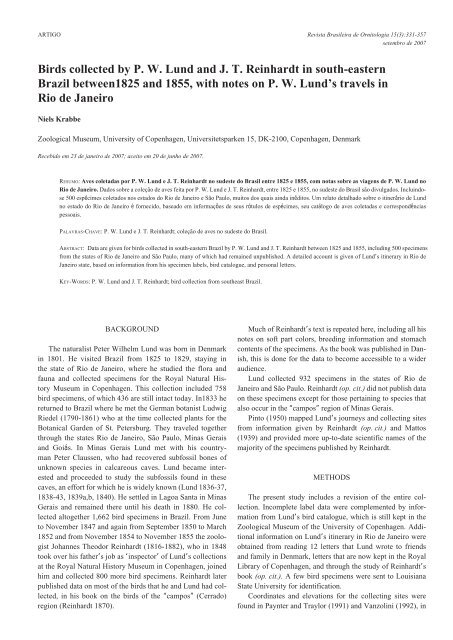You also want an ePaper? Increase the reach of your titles
YUMPU automatically turns print PDFs into web optimized ePapers that Google loves.
ARTIGo<br />
Birds collected by P. W. Lund and J. T. Reinhardt in south-eastern<br />
Brazil between1825 and 1855, with notes on P. W. Lund’s travels in<br />
Rio de Janeiro<br />
Niels Krabbe<br />
Zoological Museum, University of Copenhagen, Universitetsparken 15, DK‑2100, Copenhagen, Denmark<br />
Recebido em 23 de janeiro de 2007; aceito em 20 de junho de 2007.<br />
Resumo: Aves coleta<strong>da</strong>s por P. W. Lund e J. T. Reinhardt no sudeste do Brasil entre 1825 e 1855, com notas sobre as viagens de P. W. Lund no<br />
Rio de Janeiro. Dados sobre a coleção de aves feita por P. W. Lund e J. T. Reinhardt, entre 1825 e 1855, no sudeste do Brasil são divulgados. Incluindo‑<br />
se 500 espécimes coletados nos estados do Rio de Janeiro e São Paulo, muitos dos quais ain<strong>da</strong> inéditos. Um relato detalhado sobre o itinerário de Lund<br />
no estado do Rio de Janeiro é fornecido, baseado em informações de seus rótulos de espécimes, seu catálogo de aves coleta<strong>da</strong>s e correspondências<br />
pessoais.<br />
PalavRas-Chave: P. W. Lund e J. T. Reinhardt; coleção de aves no sudeste do Brasil.<br />
abstRaCt: Data are given for birds collected in south‑eastern Brazil by P. W. Lund and J. T. Reinhardt between 1825 and 1855, including 500 specimens<br />
from the states of Rio de Janeiro and São Paulo, many of which had remained unpublished. A detailed account is given of Lund’s itinerary in Rio de<br />
Janeiro state, based on information from his specimen labels, bird catalogue, and personal letters.<br />
Key-WoRds: P. W. Lund and J. T. Reinhardt; bird collection from southeast Brazil.<br />
BACKGRoUnD<br />
The naturalist Peter Wilhelm Lund was born in Denmark<br />
in 1801. he visited Brazil from 1825 to 1829, staying in<br />
the state of Rio de Janeiro, where he studied the flora and<br />
fauna and collected specimens for the Royal natural his‑<br />
tory Museum in Copenhagen. This collection included 758<br />
bird specimens, of which 436 are still intact to<strong>da</strong>y. In1833 he<br />
returned to Brazil where he met the German botanist Ludwig<br />
Riedel (1790‑1861) who at the time collected plants for the<br />
Botanical Garden of St. Petersburg. They traveled together<br />
through the states Rio de Janeiro, São Paulo, Minas Gerais<br />
and Goiás. In Minas Gerais Lund met with his country‑<br />
man Peter Claussen, who had recovered subfossil bones of<br />
unknown species in calcareous caves. Lund became inter‑<br />
ested and proceeded to study the subfossils found in these<br />
caves, an effort for which he is widely known (Lund 1836‑37,<br />
1838‑43, 1839a,b, 1840). he settled in Lagoa Santa in Minas<br />
Gerais and remained there until his death in 1880. he col‑<br />
lected altogether 1,662 bird specimens in Brazil. From June<br />
to november 1847 and again from September 1850 to March<br />
1852 and from november 1854 to november 1855 the zoolo‑<br />
gist Johannes Theodor Reinhardt (1816‑1882), who in 1848<br />
took over his father’s job as ‘inspector’ of Lund’s collections<br />
at the Royal natural history Museum in Copenhagen, joined<br />
him and collected 800 more bird specimens. Reinhardt later<br />
published <strong>da</strong>ta on most of the birds that he and Lund had col‑<br />
lected, in his book on the birds of the “campos” (Cerrado)<br />
region (Reinhardt 1870).<br />
Revista Brasileira de Ornitologia 15(3):331-357<br />
setembro de 2007<br />
Much of Reinhardt’s text is repeated here, including all his<br />
notes on soft part colors, breeding information and stomach<br />
contents of the specimens. As the book was published in Dan‑<br />
ish, this is done for the <strong>da</strong>ta to become accessible to a wider<br />
audience.<br />
Lund collected 932 specimens in the states of Rio de<br />
Janeiro and São Paulo. Reinhardt (op. cit.) did not publish <strong>da</strong>ta<br />
on these specimens except for those pertaining to species that<br />
also occur in the “campos” region of Minas Gerais.<br />
Pinto (1950) mapped Lund’s journeys and collecting sites<br />
from information given by Reinhardt (op. cit.) and Mattos<br />
(1939) and provided more up‑to‑<strong>da</strong>te scientific names of the<br />
majority of the specimens published by Reinhardt.<br />
MeThoDS<br />
The present study includes a revision of the entire col‑<br />
lection. Incomplete label <strong>da</strong>ta were complemented by infor‑<br />
mation from Lund’s bird catalogue, which is still kept in the<br />
Zoological Museum of the University of Copenhagen. Addi‑<br />
tional information on Lund’s itinerary in Rio de Janeiro were<br />
obtained from reading 12 letters that Lund wrote to friends<br />
and family in Denmark, letters that are now kept in the Royal<br />
Library of Copenhagen, and through the study of Reinhardt’s<br />
book (op. cit.). A few bird specimens were sent to Louisiana<br />
State University for identification.<br />
Coordinates and elevations for the collecting sites were<br />
found in Paynter and Traylor (1991) and Vanzolini (1992), in

















